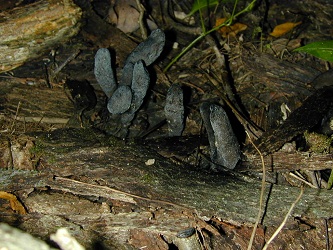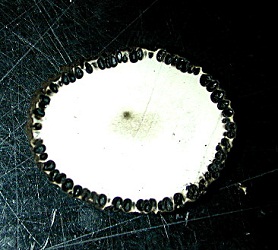What Does It Look Like and What Is Its Lifecycle?
Xylaria polymorpha appears in multiple colors and varying sizes. The fruiting body (the part usually seen above ground) ranges in length from 2-15 cm (including the rooting base underground) and from 0.5-3 cm in diameter14. The shapes of the fruiting body are club-like or finger-like shapes; however, the fruiting bodies can also be flattened, still maintaining a rounded tip10.

In the early spring, the juvenile fruiting body starts out as a whitish to tan color, but very quickly starts to form conidia (asexual spores), coating the fruiting body in a pale bluish to purplish dust, except for the tip (which remains the original whitish color)10,14. The conidia covered form is known as the "candlesnuff" stage18. Once summer starts, the conidia slowly begin to flake off, leaving behind a dull black-brown color and a still paler tip10,14.

Eventually, in late summer and early fall, the whole fruiting body becomes a dark black color with a slightly pimpled and wrinkly texture10.
From June through November X. polymorpha grows visibly on decaying wood, but the fruiting bodies may remain year round because of their durable structure22.
Dead man's fingers undergoes the alternation of generations life cycle of most fungi (also seen in all plants; e.g. Ananas comosus)19. Although this is true, Xylaria fungi have complicated life cycles, switching between asexual and sexual stages multiple times10. On this webpage, a general lifecycle of fungi will be covered to help the readers understand the general lifecycle of a fungus. Spore production and release will also be described for the reader's further enjoyment.
To the right, a diagram of
the fungi lifecycle explains changes in
ploidy and the multiple stages of a fungus during
its lifecycle. The story arbitrarily starts at the dikaryotic mycelium (at the red star
in the diagram). The dikaryotic mycelium (a network of
interconnected thread-like structures called hyphae with multiple
nuclei sometimes separated by septum) usually grows underground or
in substrate. When conditions are suited for sexual spore
production, the fungi begins forming a fruiting body from the
dikaryotic mycelium. Eventually the fruiting body makes its way to
the surface where spore producing structures fuse two of their
nuclei together in a process called karyogamy. These now diploid
structures produce haploid spores through meiosis. The fungus then
releases the haploid spores into the wind where the spores then
germinate and grow into haploid mycelium. The haploid mycelium may
then go through an asexual sexual cycle producing asexual spores
(conidia) through mitosis or fuse with another haploid mycelium in a
process called plasmogamy. The two haploid mycelium become one
dikaryotic mycelium (meaning that the mycelium contains two sets of
different haploid DNA that remain in separate nuclei). Once the
dikaryotic mycelium forms, it may continue to grow indefinitely for
the remainder of its life or until it receives signals from the
environment initiating the growth of another fruiting body. Although
there are many stages in this lifecycle, most ascomycota fungi (including
Xylaria polymorpha spend the
majority of their lives in haploid stages, reproducing by conidia19.
story arbitrarily starts at the dikaryotic mycelium (at the red star
in the diagram). The dikaryotic mycelium (a network of
interconnected thread-like structures called hyphae with multiple
nuclei sometimes separated by septum) usually grows underground or
in substrate. When conditions are suited for sexual spore
production, the fungi begins forming a fruiting body from the
dikaryotic mycelium. Eventually the fruiting body makes its way to
the surface where spore producing structures fuse two of their
nuclei together in a process called karyogamy. These now diploid
structures produce haploid spores through meiosis. The fungus then
releases the haploid spores into the wind where the spores then
germinate and grow into haploid mycelium. The haploid mycelium may
then go through an asexual sexual cycle producing asexual spores
(conidia) through mitosis or fuse with another haploid mycelium in a
process called plasmogamy. The two haploid mycelium become one
dikaryotic mycelium (meaning that the mycelium contains two sets of
different haploid DNA that remain in separate nuclei). Once the
dikaryotic mycelium forms, it may continue to grow indefinitely for
the remainder of its life or until it receives signals from the
environment initiating the growth of another fruiting body. Although
there are many stages in this lifecycle, most ascomycota fungi (including
Xylaria polymorpha spend the
majority of their lives in haploid stages, reproducing by conidia19.
When taking a cross section of one of the black, mature fruiting bodies a person observes a ring of black dots around the outside of edge of the light colored insides of the mushroom called perithecia. Perithecia are flask shaped structures that house many asci (sacs) filled each with usually eight ascospores (sexual haploid spores)14,18. To release these spores, each ascus grows toward the small opening in the perithecium (the ostiole) until it has exposed itself to air. Then the ascus ejects its ascospores into the air. Since their are many asci within each perithecia, X. polymorpha spends months or even years releasing its spores. Long term spore dispersal allows X. polymorpha to increase its chances of releasing spores during a time when conditions favor spore germination and growth18.



Now that you know what X. polymorpha looks like and how it reproduces and grows, find out where it lives and how it interacts with other organisms that live in the same habitat.